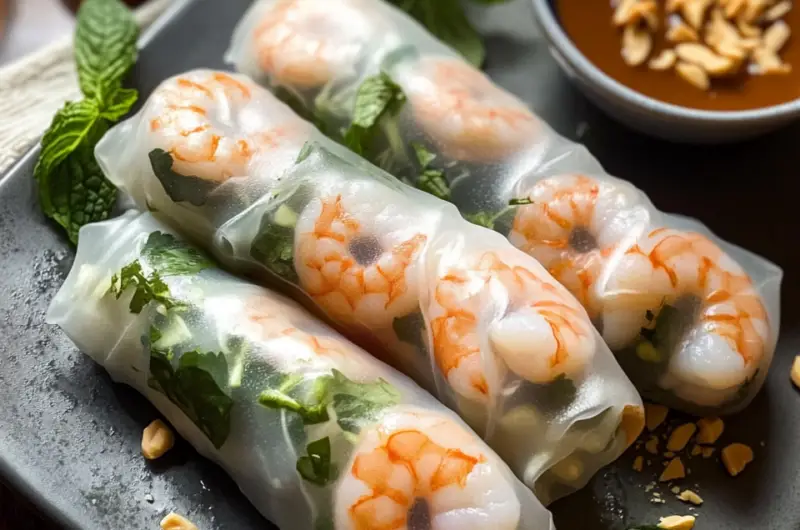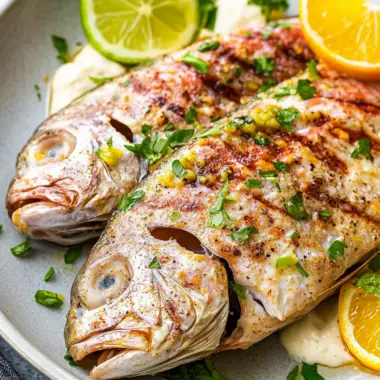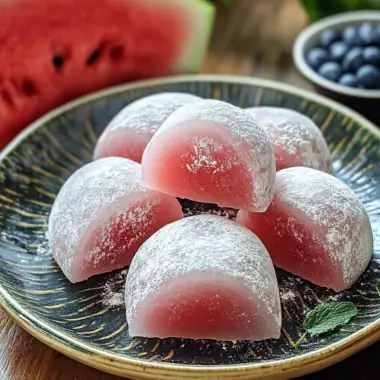The Vietnamese Spring Roll is a vibrant and healthy dish that perfectly captures the essence of Vietnamese cuisine fresh herbs, light rice noodles, crisp vegetables, and tender shrimp all wrapped up in delicate rice paper. It’s a dish that’s as pleasing to the eyes as it is to the tastebuds, offering layers of flavor and texture in every bite. Perfect as an appetizer, snack, or even a light main course, these spring rolls are incredibly versatile and customizable. Whether you’re entertaining guests or simply craving something refreshing and satisfying, these rolls are a surefire hit. Pair them with a creamy peanut-hoisin dipping sauce and you’ve got an unforgettable flavor combination that’s both nutritious and crowd-pleasing.
Full Recipe:
Ingredients:
-
8 rice paper wrappers
-
1/2 lb cooked shrimp, sliced in half lengthwise
-
1 cup cooked vermicelli noodles
-
1 cup shredded lettuce
-
1/2 cup fresh mint leaves
-
1/2 cup Thai basil leaves
-
1/2 cup cilantro
-
1 medium carrot, julienned
-
1 small cucumber, julienned
-
Warm water for soaking rice paper
For Dipping Sauce:
-
1/4 cup hoisin sauce
-
2 tbsp peanut butter
-
2 tbsp water
-
1 tsp sriracha
-
Chopped peanuts for garnish
Directions:
-
Fill a large shallow dish with warm water. Dip one rice paper wrapper into the water for 5–10 seconds until soft and pliable.
-
Lay the wrapper flat on a clean surface.
-
Arrange 2-3 shrimp halves in a row at the bottom third of the wrapper.
-
Add a small amount of vermicelli, lettuce, herbs, carrots, and cucumber.
-
Fold the bottom of the wrapper over the filling, fold in the sides, and roll tightly. Repeat with the remaining ingredients.
-
For the sauce, whisk together hoisin, peanut butter, water, and sriracha until smooth. Top with chopped peanuts.
-
Serve the rolls fresh with the dipping sauce on the side.
Prep Time: 20 minutes | Cooking Time: 0 minutes | Total Time: 20 minutes
Kcal: 160 kcal | Servings: 4 servings
The Cultural Essence of Vietnamese Spring Rolls
Vietnamese Spring Rolls, known as Gỏi Cuốn in Vietnamese, are more than just a delicious appetizer or snack they are a celebration of balance, freshness, and community in Vietnamese cuisine. Often served at family gatherings, street food stalls, and high-end Vietnamese restaurants, these translucent rolls are an emblem of the country’s culinary identity. Wrapped in delicate rice paper and filled with a combination of fresh herbs, vermicelli noodles, crisp vegetables, and tender shrimp or other proteins, they embody the Vietnamese philosophy of “eating light but flavorful.”
Unlike their fried counterparts such as Chả Giò (fried spring rolls), Gỏi Cuốn are not cooked after assembling. They are served cold or at room temperature, offering a refreshing option during hot weather or when craving a clean, vibrant dish. Their simplicity in preparation allows the natural flavors and textures of the ingredients to shine, making them a favorite for both novice home cooks and professional chefs.
A Culinary Symbol of Balance
At the heart of Vietnamese cooking is the idea of balance not just in flavors, but also in texture, color, and nutritional value. Vietnamese Spring Rolls exemplify this approach beautifully. Each element contributes to a harmonious experience:
-
Fresh herbs like mint, Thai basil, and cilantro bring aromatic brightness.
-
Vegetables like carrots and cucumber offer a satisfying crunch.
-
Protein options such as shrimp or tofu add richness and satiety.
-
Vermicelli noodles provide a soft, chewy counterbalance to the crisp vegetables.
-
Rice paper serves as the delicate but sturdy wrapping that holds it all together.
Dipped into a flavorful hoisin-peanut sauce or a zesty nuoc cham (fish sauce-based dip), the rolls are transformed into a bite bursting with contrast sweet and salty, soft and crunchy, earthy and herbal.
Versatility and Customization
One of the most appealing features of Vietnamese Spring Rolls is their adaptability. They are a blank canvas for culinary creativity and dietary preferences. You can fill them with a variety of proteins including shrimp, grilled pork, shredded chicken, tofu, or even thinly sliced beef. The herb and vegetable combinations are equally flexible whatever is fresh, in-season, or preferred by the cook can be used.
This flexibility makes them ideal for family dinners or parties where guests have diverse tastes or dietary restrictions. You can even create a “roll-your-own” spring roll bar at gatherings, where everyone assembles their own rolls based on individual preferences. It’s interactive, fun, and encourages a sense of connection over food.
The Importance of Fresh Ingredients
Freshness is paramount in Vietnamese Spring Rolls. Unlike many cooked dishes where ingredients can be coaxed into flavor with heat and seasoning, spring rolls rely on the inherent taste and texture of their raw ingredients. This is why sourcing high-quality, fresh herbs, crisp vegetables, and plump shrimp or well-seasoned tofu is essential to achieving the authentic taste.
In Vietnamese markets and homes, the preparation of spring rolls often starts with a trip to the market for the freshest produce of the day. The rice paper must be pliable but not soggy, the herbs must be fragrant and unbruised, and the shrimp should be just cooked not overdone to preserve their natural sweetness and tender texture.
Health Benefits of Vietnamese Spring Rolls
Vietnamese Spring Rolls are a health-conscious food lover’s dream. They are low in calories, packed with fiber and nutrients, and typically gluten-free depending on the dipping sauce. The generous use of herbs like mint, basil, and cilantro not only enhances the flavor but also provides antioxidants and digestive benefits.
Moreover, because they are not fried, they retain all the nutritional value of their raw components. The inclusion of lean proteins like shrimp or tofu adds an excellent source of low-fat protein, and the use of rice noodles ensures a gluten-free grain option that is easy on the stomach.
These qualities make spring rolls suitable for a variety of dietary goals including weight management, gluten-free living, heart health, and more.
A Journey Through Vietnamese Food Culture
To truly appreciate the Vietnamese Spring Roll, one must understand its place in Vietnamese food culture. Meals in Vietnam are about more than sustenance they are about gathering, sharing, and respecting tradition. The act of making and eating spring rolls with others reflects the importance of community and hospitality.
In Vietnam, food is commonly placed at the center of the table, where everyone can help themselves. The hands-on nature of assembling a spring roll layering ingredients, rolling the wrapper, and dipping into sauce mirrors this communal dining style. It’s tactile, intimate, and full of personal expression, which is why these rolls are often part of celebratory meals and family dinners.
Dipping Sauces: The Finishing Touch
No Vietnamese Spring Roll is complete without its perfect dipping sauce. While nuoc cham is a traditional fish sauce-based dip with lime juice, sugar, garlic, and chili, the hoisin-peanut sauce has gained popularity for its creamy, savory-sweet flavor that complements the herbal notes of the roll.
The peanut dipping sauce often includes hoisin sauce, peanut butter, garlic, and a splash of water or coconut milk to create a smooth consistency. Garnished with crushed peanuts and a bit of chili oil, it elevates the roll into something truly irresistible.
Home cooks can even experiment with fusion-style sauces like mango-lime vinaigrettes, sesame soy dips, or sriracha-spiked yogurt for a global twist on the traditional.
Serving Suggestions and Pairings
Vietnamese Spring Rolls can be enjoyed as an appetizer, light lunch, or even a main dish when served with a generous side of dipping sauce and perhaps a bowl of pho or a chilled noodle salad. For beverages, consider pairing them with:
-
Jasmine iced tea
-
Sparkling water with lime
-
A crisp white wine like Sauvignon Blanc
-
A light beer or rice lager
Presentation is also key. Serve the rolls on a banana leaf or bamboo platter for an authentic look, and don’t forget small individual bowls of sauce for each guest. Garnish with extra herbs or edible flowers for added visual appeal.
Making Spring Rolls at Home: Tips for Success
For those trying their hand at spring rolls at home, a few pro tips can make the process smoother:
-
Soak rice paper one at a time and only for a few seconds. It continues to soften as you roll.
-
Keep your filling minimal. Overstuffing makes it harder to roll and more likely to tear.
-
Roll on a damp surface like a moistened cutting board to prevent sticking.
-
Use plastic gloves or wet your hands slightly if the rice paper becomes too tacky.
-
Practice makes perfect. Your first few rolls might not look perfect, but they will still taste amazing.
Conclusion:
Vietnamese Spring Rolls are more than just a healthy, flavorful food they are a culinary tradition that speaks to the heart of Vietnamese culture. Their fresh ingredients, beautiful presentation, and endless adaptability make them a staple in kitchens around the world.
Whether you’re making them for the first time or returning to a family favorite, each roll is a celebration of freshness, flavor, and care. Embrace the hands-on process, enjoy the communal spirit, and don’t forget the dipping sauce. Once you master this dish, you’ll find yourself returning to it again and again for its versatility, lightness, and cultural charm.








